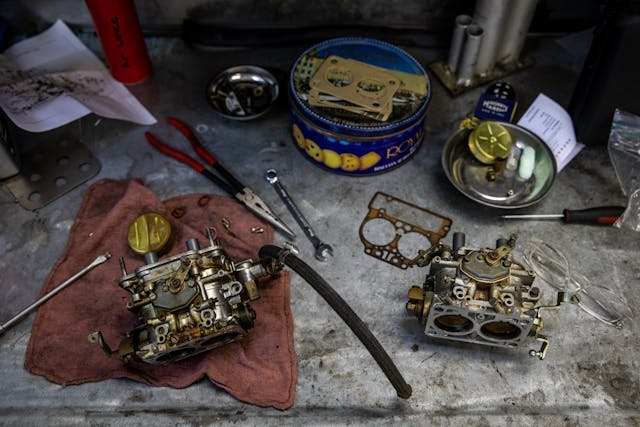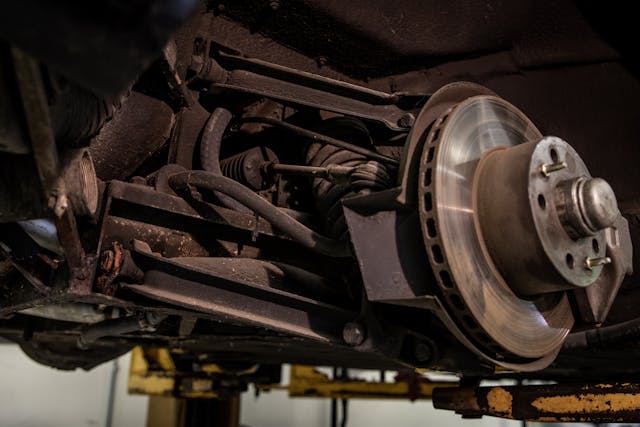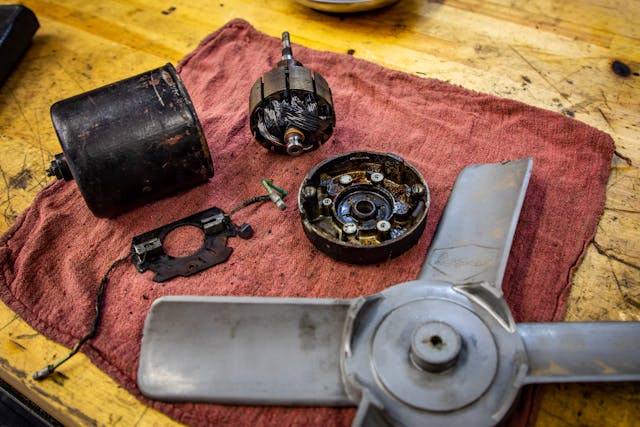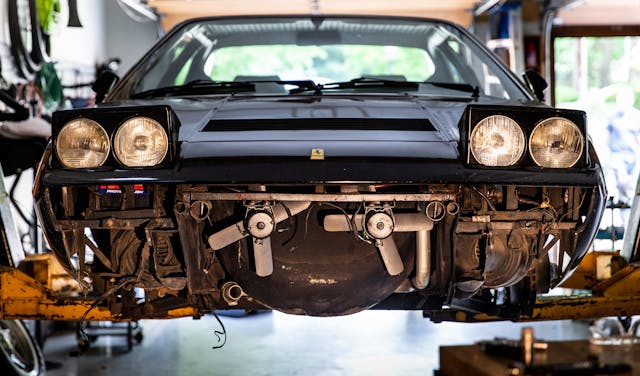$25K Project Dino: Our editor-in-chief does not despair—yet
Every project car starts with an avalanche of known unknowns. Sure, we all do our best when inspecting a car for potential purchase, but since we rarely have the perfect tools, time, or space for the job, few initial assessments reveal all the flaws. Let’s also not forget the fog of the new-to-me buying fever, which was running hot in my brain after years of looking for the right GT4.
(This past spring Editor-in-Chief Larry Webster set forth on a bold path to fix up the 1975 Ferrari Dino 308 GT4 he bought for $25,000. He wasn’t sure our fine readers would be all that interested in hearing about it, but your vigorous responses proved otherwise. Forward he forged. –Ed.)
In an ideal world, I would have brought along a Dino expert, put the car on a lift, and spent half a day with the proverbial fine-toothed comb. For a variety of reasons that include time and money, I didn’t go that far. I had researched the model, driven a few, and inspected a handful. I knew the version I wanted: the lighter Series 1 edition, one that was sold in Europe because the bumpers are smaller than those on the U.S. cars.
Editor-at-large Aaron Robinson served as critical wingman during the inspection. I think a second opinion is beyond wise, and in this case, I had someone with greater domain experience. Robinson has restored two Lamborghini Espadas, and he had a cooler head, compared with my hot one.
We inspected the car in a small garage attached to a Long Beach, California, bungalow. I needed to determine if this 25-grand Italian was too much of a project for my wallet. A long punch list of needs was expected, but the potentially very expensive items are the engine, gearbox, body, and frame. After a couple of hours, Robinson gave me the nod that he didn’t think my potential purchase was reckless, so I made the deal and shipped the car to my Michigan home. The following photos reveal what we looked for in California and the inevitable additional discoveries made in my garage.
Rust damage

The GT4 has a steel-tube frame. We checked the corners of the car for evidence of accident repair—crinkled metal or parts that didn’t line up—but found no evidence of damage. There were bubbles in the paint, however, which indicate rust. Bubbles are typically a red flag, because there’s no way to know the extent without stripping the paint. Here, the bubbles were in superficial areas like this fender, but not in the rockers. Later, I found more extensive rust in the trunk, hidden by undercoating. There’s always more than you can see.
Suspension bushings

The GT4 is built like a race car, with two A-arms at each corner. They attach to the frame with rubber bushings. Just like rubber engine hoses, which oxidize with age, the bushings suffer the same fate and will all need replacing to ensure the car handles as designed.
Engine and transmission

This car was parked in 2003 and didn’t run. There was no way to check the gearbox, but we did do a compression test to check the engine’s health. You’re looking for uniform pressure across all eight cylinders; in this case, the #4 cylinder was low. Next would be a leak-down test, but we didn’t have the requisite compressed air. The #4 cylinder issue could be caused by a bad valve or broken piston ring—or it could simply be a symptom of sitting. Surface rust on the cylinder wall could prevent the rings from properly sealing. I gambled here, betting there was at least a 75 percent chance that I could drive the car with the engine as is.
Carburetors

All four of the GT4’s Webers needed a rebuild. That’s simple in theory, but there are dozens of springs, levers, and tiny pieces. Thankfully, full-time Ferrari mechanic Tom Yang posted a video that walked through the entire process. That, along with the Ferrari parts diagram, got me by, although I did break a small tab that holds the float. Replacement tabs are hard to find, so I asked around on Facebook for help. Dan Binks, former chief mechanic for the Corvette Le Mans team, offered to weld it. Others I called didn’t think welding was possible. “That’s just what I like,” Binks said, as he flipped down his welding goggles. “A challenge.” He used a TIG welder and reattached the piece in 15 minutes. Sometimes you get lucky by knowing the right people.
Timing belts

The 3.0-liter Ferrari V-8 uses two toothed rubber belts to drive the camshafts, and they degrade over time regardless of mileage. If they break while the engine is running, the pistons will crash into the valves. Replacement requires extreme care to ensure the relative position of the belts on gears. Once again, the internet came to the rescue with a highly detailed DIY procedure that provided useful tips to hold the belts in place as I slid them over the sprockets.
Brakes

The brakes are pretty DIY-friendly. They’re also weapons-grade, with large front rotors—stouter than I expected for a 2500-pound car—as well as ducts for effective air-cooling. As it was the least expensive Ferrari, just $22,550 in 1975, I didn’t expect those details, which tell me that the engineers designed the GT4 to be enthusiastically driven.
Fan motor

Any project is an opportunity to learn. Rather than replacing the old fan motors with modern units, a local friend, who restored his own GT4, showed me how to rebuild them. Small metal blocks, called brushes, transfer electricity to the fan shaft, and they wear out over time. The fix is to solder in new brushes, clean, and lubricate.


